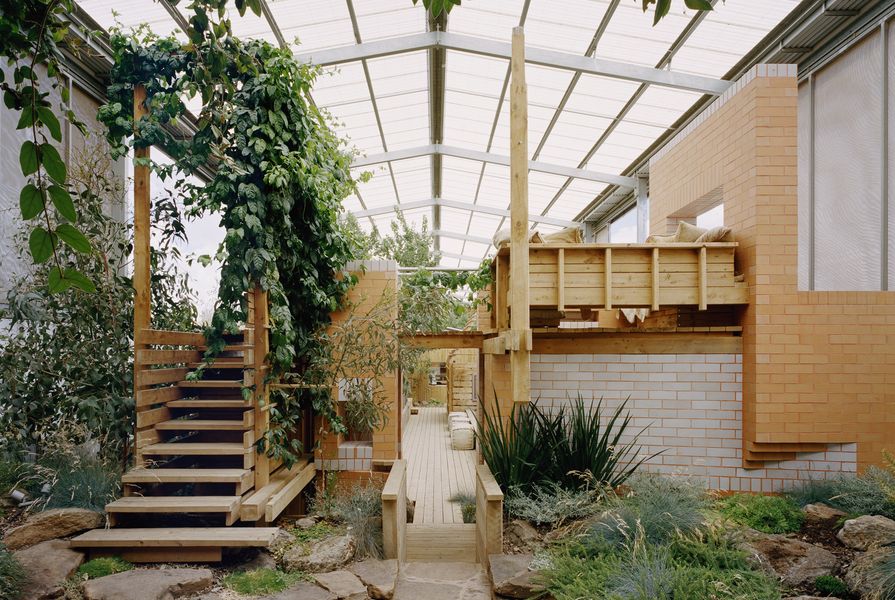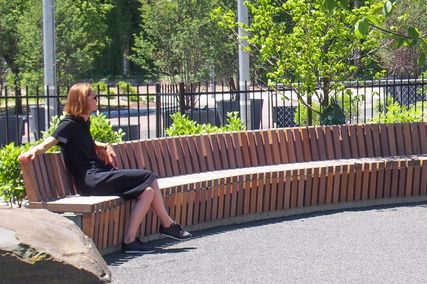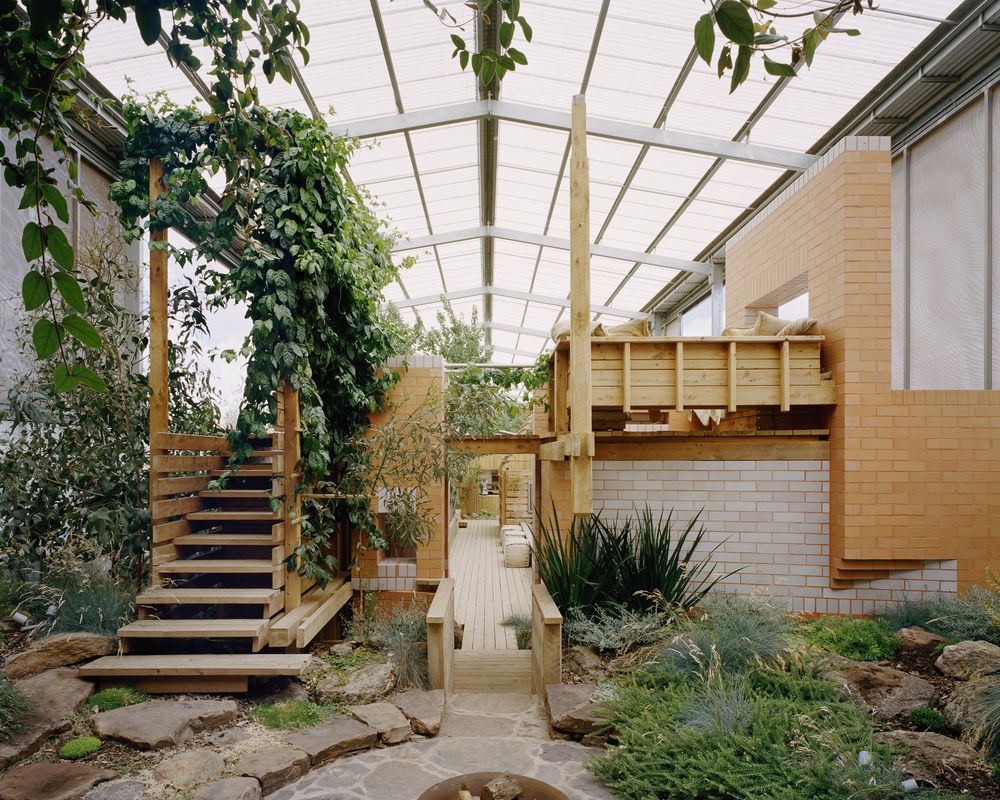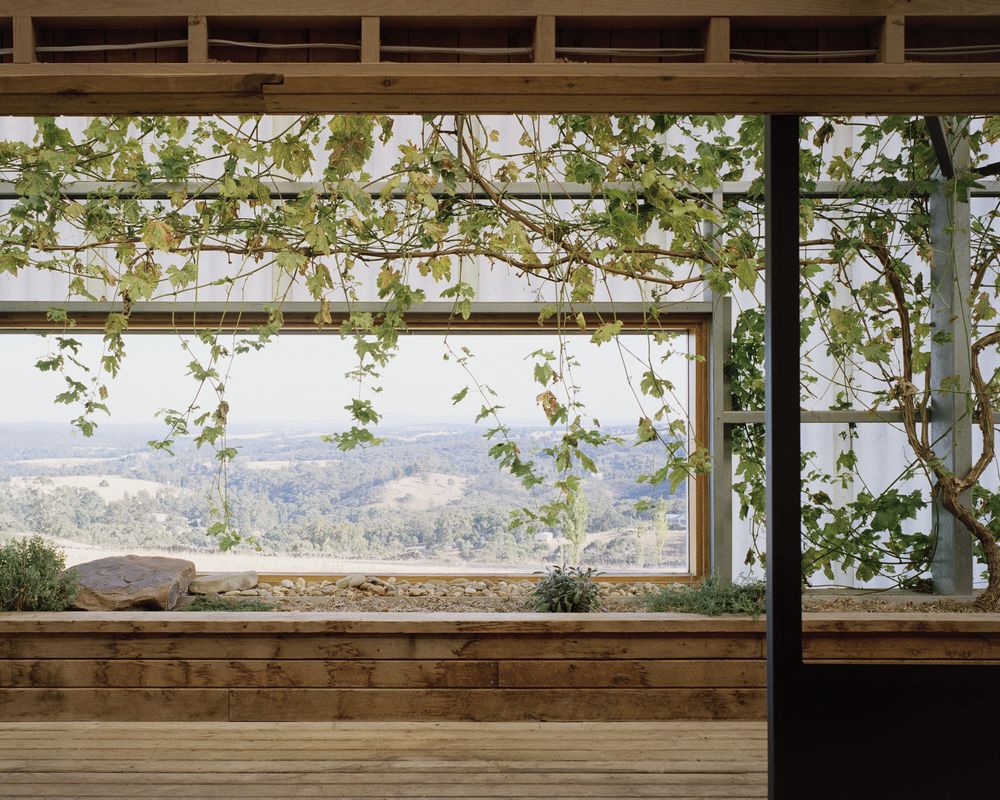When you can see the horizon, the immensity of a landscape setting is sublime. It gives us perspective on our small place in the world, prompting our mind to wander and allowing dreaming to begin. By contrast, the ability to take refuge and find retreat from the vastness of the world allows us to recalibrate at the human scale and reflect on a mindful existence. Daylesford Longhouse by Partners Hill responds to both the dreaminess of a landscape setting and the very real human yearning for respite and reflection.
On arrival at the site, ninety-three kilometres north-west of Melbourne, the full 110-metre length of the prefabricated shed structure is visible behind a series of landscaped berms. The scale of the structure responds to the vastness of the landscape, and the translucent shell appears to have a green tint that is in actuality a reflection of the grasses planted on the berm. Within the single volume, a series of buildings are arranged throughout a productive and leafy garden greenhouse. The size, detailing and craftsmanship of the buildings connect to the human scale and this inward focus (with the exception of one large horizontal opening along the northern edge) promotes mindfulness and nurtures the soul.
The design is based on a remarkably simple and pragmatic idea of containing all three functions of the brief – living quarters, a cooking school and a working farm building – within the one, long shed structure. This is an uncommon approach to farm buildings, which are more typically dotted across a site and delineated according to function. There’s something quite magical and otherworldly about entering this space, but all design decisions for this building have masterful clarity and are based on rational thought processes. As Timothy Hill, director of Partners Hill, aptly points out, “it turns out common sense yields all sorts of poetic pleasures. It’s great fun.”
Sitting low among a series of landscaped berms, the home presents as an industrial shed, its cornice decorated with dots and dashes to spell out “longhouse” in Morse code.
Image: Rory Gardiner
Starting with the prefabricated shed had benefits during the construction process, eliminating the need for waterproofing and ensuring weathering would not be an issue. In spite of the building’s apparent industrial structure, there is something more elegant and composed about it. The simple addition of a folded and perforated cornice around the north and south edges of the roof conceals the gutter and prevents the shed from looking “too agricultural.” Decorated with dots and dashes that spell out the word “longhouse” in Morse code, the cornice was inspired by classical gable-ended buildings in the tradition of Karl Friedrich Schinkel and Sigurd Lewerentz, which have an extruded gable form that dignifies the shed typology.
Hill refers to other classical building types as precedents for this project – in particular the villa, which for Hill is an enticing alternative to the “Australian obsession with romancing the country cottage.” The distinct parts of the Longhouse are interrelated and dependent on one another to create the larger architectural complex, yet each portion provides an isolated experience and performs completely different functions. Interior and exterior architectural features are intertwined throughout the building such that you lose track of whether you are inside or outside – it’s a confusing moment when you realize you are walking around “outside” in only your socks. A playful bathroom of terracotta bricks with white-glazed side and end and terracotta mortar is actually an outdoor bathroom, open to the fields beyond.
A playful outdoor bathroom of terracotta bricks with white glazed sides and ends is open to the fields beyond.
Image: Rory Gardiner
An important factor in determining the length and proportions of the building was the calculation of how much water needs to be harvested in order to sustain a productive and healthy garden. With no precedent for this type of project, the design process involved a series of experiments and calculations – research that could now serve as a model for a self-sustaining and shared living arrangement. There is also a sense that the Longhouse itself could be multiplied or extended, to accommodate both more plants and more people.
Technology was sourced from the agricultural industry, rather than the building industry – for example, the planted portion of the building is variably ventilated and pollinated with steel-framed, partially porous agricultural fabric.
The timber carpentry is chunky and raw and there is an honest expression of structure and materiality throughout the project. Close attention has been paid to the quality of light and the way it enters the building, while steady acoustics give a consistency to the internal space that evokes feelings of calm and comfort.
At the shed’s eastern end, the industrial scale diminishes to a domestic one in the transition to the living quarters and the mood shifts to encourage bunking in and getting cosy for the night. Passive Haus systems control the sealed interior environments within the shed. Quirky features foster a sense of play, such as a hidden first-floor toilet with a light well to the kitchen below, walls that push and pull to allow for recessed light fittings, low-level window placements and hidden daybeds. In a similar vein, the stableman’s quarters have a high ceiling that reveals the copper colour of the insulation film and is littered, intentionally, with too many pendant lights. These playful moves transform ordinary rooms into something extraordinary.
In the modestly sized living quarters at the eastern end of the structure, the industrial shed gives way to a more domestic setting.
Image: Rory Gardiner
A garden kitchen in the centre of the plan is used for a series of weekend cooking courses and forms the heart of the scheme. It’s the social hub, the place to come together and cook the produce from the greenhouse and farm. It’s also the last piece of the puzzle to be built after a staged ten-year design and construction process (although there are whispers of new ideas). Above the garden kitchen, sleeping quarters accommodate visitors, guest kitchen workers or seasonal WWOOFers (World Wide Opportunities on Organic Farms volunteers, who work in return for meals, accommodation and culture) – this is a home not just for clients Ronnen Goren and Trace Streeter, but also for others to experience and enjoy, friends, transient workers and paying customers alike.
It is important to note that this is not a weekender – in fact, the whole concept of this house is purposefully against the idea of going somewhere out of the city to do nothing. Rather, the house is intentionally active and demands your attention. Visitors are always doing something, be it milking a cow, making cheese or pruning an avocado tree. It’s a place that takes you back to the fundamentals of living.
This is a masterful building that is clearly designed by an architect who has rehearsed the spatial sequencing puzzle of residential architecture many times. It makes all the right moves, and then adds something new to the equation that is unexpected and overwhelmingly delightful. The benefits of biophilia are proven, but Longhouse allows for more than simply a human connection to nature. It simultaneously embeds you in nature and protects you from it. It allows for both blissful dreaming and mindful concentration. The spatial delight and magic of this space is born from rationality and classical sequencing techniques. Longhouse is an embodiment of dualities, but more importantly it focuses our attention on the fundamentals of our existence on earth and might offer some hints to a sustainable model of self-sustained living.
Credits
- Project
- Daylesford Longhouse
- Architect
- Partners Hill
Australia
- Project Team
- Timothy Hill (design director), Domenic Mesiti, Michael Hogg (architects), Andrew D'Occhio, Jonathan Chamberlain (graduate of architecture)
- Consultants
-
Builder
Nick Andrew Construction
Engineer Tim Hall and Associates
Landscaping Partners Hill
Masonry consultant Elvis and Rose
- Site Details
-
Location
Daylesford,
Vic,
Australia
Site type Rural
- Project Details
-
Status
Built
Completion date 2019
Category Residential
Type New houses
Source
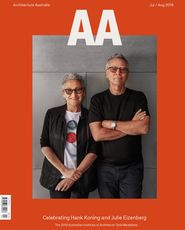
Project
Published online: 29 Jul 2019
Words:
Katelin Butler
Images:
Rory Gardiner
Issue
Architecture Australia, July 2019

